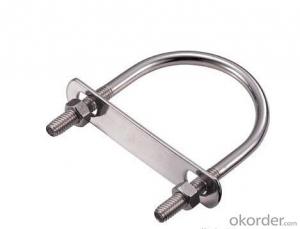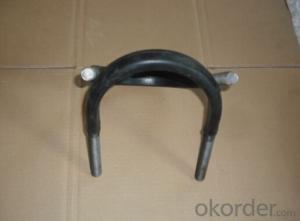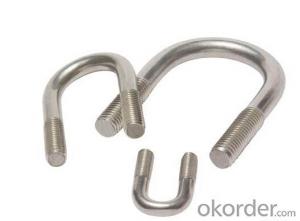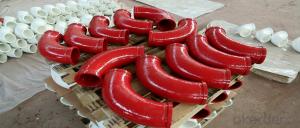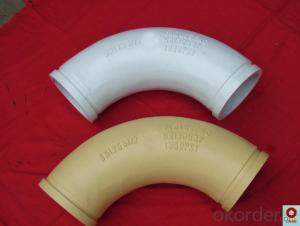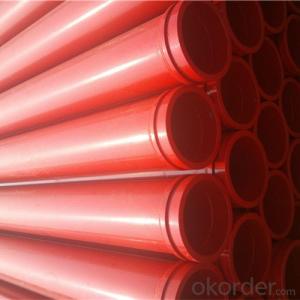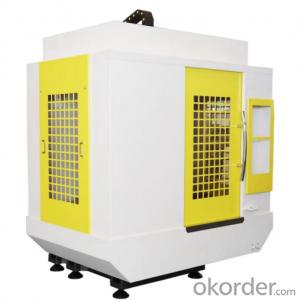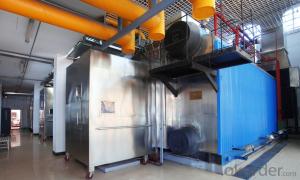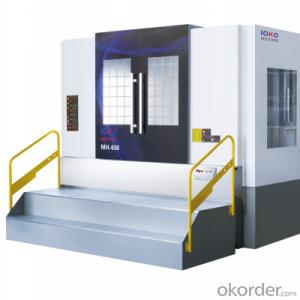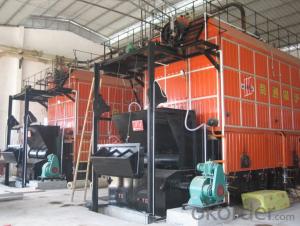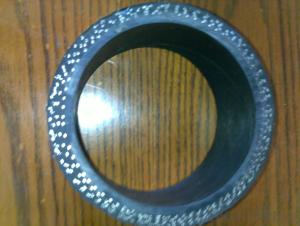Steel Galvanized U type pipe clampp with plate
- Loading Port:
- Shanghai
- Payment Terms:
- TT OR LC
- Min Order Qty:
- 10 set
- Supply Capability:
- 1000 set/month
OKorder Service Pledge
OKorder Financial Service
You Might Also Like
CONCRETE PUMP SPARE PARTS
Steel Galvanized U type pipe clampp with plate
Specifications
stainless steel u bolt clamp steel pipe
1.Manufactur supply directly.
2.Size:M4-M48.etc
3.ISO,SGS.
4.Grade:201,304,316...
stainless steel u bolt clamp steel pipe
Size:stainless steel u-bolts
M6x16-50
M8x20-100
M10x20-100
M12x20-100
M14x30-100
M16x30-100
M18x40-100
M20x40-100
M22x50-100
M27x50-100
M30x50-100
M36x50-100
material:stainless steel
201
304 0Cr18Ni9 304L 00Cr19Ni10
321 0Cr18Ni9Ti 316 0Cr17Ni12Mo2
316L 00Cr17Ni14Mo2 310S 0Cr25Ni20
surface:bright
Tolerance: +/-0.015mm
Grade: 4.6 4.8 5.6 5.8 6.8,etc
DN125 Concrete Pump Clamp Coupling
Type-HD
| 1.5" clamp HD |
2" clamp HD |
| 3" clamp HD |
| 4" clamp HD |
| 3"clamp HD (adjustable) |
| 4"clamp HD (adjustable) |
| 2.5" clamp HD |
| 5" clamp HD |
| 5" clamp HD (adjustable) |
Type-Bolt& snap
Bolt Clamp 2" |
| Bolt Clamp 3" |
| Bolt Clamp 4" |
| Bolt Clamp 5" |
| Bolt Clamp 6" |
| Bolt Clamp Boom Bracket Type 5" |
| Two Bolts Boom Clamp 5" |
| Snap Clamp 2" |
| Snap Clamp 3" |
| Snap Clamp 4" |
| Snap Clamp 4.5" |
| Snap Clamp 5" |
| Snap Clamp 6" |
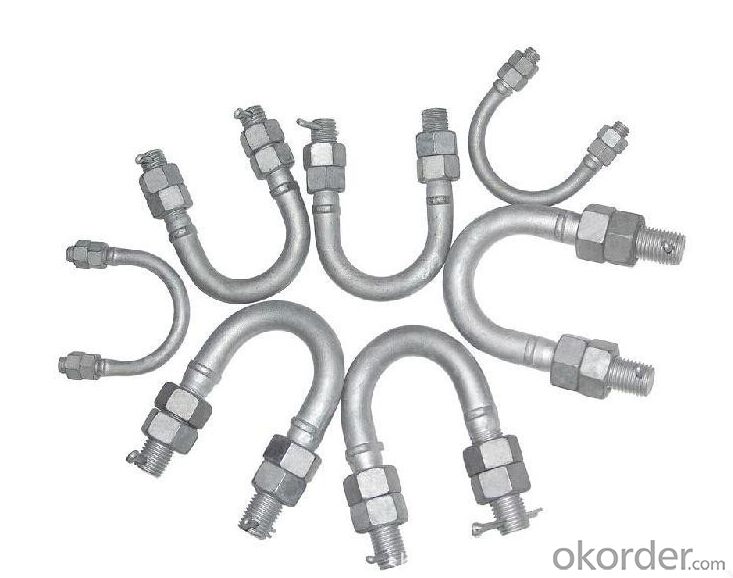
- Q:Can I reuse old concrete pump spare parts?
- Reusing old concrete pump spare parts is a possibility, depending on their condition. In the event that the spare parts are in good working order and successfully pass the required inspections, they can be reused to cut costs and minimize waste. Nevertheless, it is crucial to verify that the recycled spare parts are suitable for the specific model and type of concrete pump in use. Seeking advice from a professional or the manufacturer is advised in order to ascertain the safety of reusing the old spare parts.
- Q:What are the indications of a clogged or damaged concrete pump filter?
- Some indications of a clogged or damaged concrete pump filter include decreased pumping pressure, reduced flow rate, increased fuel consumption, and irregular or inconsistent concrete output. Additionally, if the concrete pump filter is severely clogged or damaged, it may cause the pump to overheat or shut down completely. It is important to regularly inspect and clean or replace the filter to ensure optimal performance and prevent any potential damage to the pump.
- Q:Can concrete pump spare parts be installed by the pump owner or operator, or is professional assistance required?
- Professional assistance is generally required for the installation of concrete pump spare parts. The complexity and technical nature of these parts, along with the potential safety risks involved, necessitate the expertise of trained professionals. Attempting to install the spare parts without proper knowledge and experience could lead to improper functioning of the pump and even accidents. It is always recommended to seek professional assistance to ensure the correct installation and safe operation of concrete pump spare parts.
- Q:What is the purpose of a concrete pump electric motor?
- The purpose of a concrete pump electric motor is to provide the necessary power and energy to operate the concrete pump. The motor converts electrical energy into mechanical energy, which is then used to drive the pump's hydraulic system. This hydraulic system is responsible for sucking in concrete from the hopper and pumping it through the pipes to the desired location. The electric motor ensures a smooth and efficient operation of the concrete pump, allowing for precise placement of the concrete and increased productivity on construction sites. Additionally, the use of an electric motor eliminates the need for manual labor and reduces emissions compared to traditional diesel-powered pumps, making it a more environmentally friendly option.
- Q:How often should hopper screens be cleaned or replaced?
- It is important to clean or replace hopper screens regularly, usually every 3 to 6 months, depending on how often they are used and the type of materials being processed. Keeping the hopper screens clean is crucial for maintaining peak performance and preventing clogs or obstructions. If the screens become excessively dirty or damaged, they should be replaced immediately to avoid interruptions in material flow and potential equipment damage. Regularly maintaining and inspecting the hopper screens will help extend their lifespan and ensure the entire system operates smoothly.
- Q:How can a faulty agitator motor affect the concrete mixing process?
- The concrete mixing process can be significantly affected by a faulty agitator motor in several ways. To begin with, the rotation of the mixing drum, which is crucial for thoroughly blending all the ingredients in the concrete mix, is the responsibility of the agitator motor. If the motor is not functioning properly or is faulty, it can lead to inadequate mixing. This can cause inconsistencies in the concrete mixture, with certain portions being over-mixed while others are under-mixed. Consequently, the concrete may not achieve the desired level of strength, durability, or uniformity. Additionally, a faulty motor can cause irregular or insufficient agitation, resulting in the formation of lumps or clumps in the concrete mix. These lumps can have a negative impact on the quality of the final product as they can create weak spots or air pockets within the concrete. Moreover, the presence of lumps can compromise the overall workability of the mix, making it more challenging to handle and place. This, in turn, can affect the efficiency and productivity of the construction project. Moreover, an uneven distribution of materials within the mixing drum can occur due to a faulty agitator motor. This can cause variations in the proportions of aggregates, cement, water, and additives, all of which are crucial for achieving the desired properties of the concrete. Inconsistent material distribution can result in concrete with inadequate compressive strength, reduced durability, and increased susceptibility to cracking or other forms of damage. Lastly, a malfunctioning agitator motor can lead to increased mixing time as it may take longer to achieve the desired level of homogeneity in the concrete mix. This can have an impact on the overall productivity of the concrete mixing process, resulting in delays in construction schedules and increased costs. In summary, a faulty agitator motor can have a significant impact on the concrete mixing process. It can lead to inadequate mixing, the formation of lumps, uneven material distribution, and increased mixing time. All these factors can contribute to a decrease in the quality of the final concrete product, compromising its strength, durability, workability, and overall performance.
- Q:How often should concrete pump water pumps be inspected and replaced?
- The inspection and replacement frequency for concrete pump water pumps relies on multiple factors, including workload, operating conditions, and maintenance practices. It is generally advisable to inspect the water pump once a month to ensure proper functioning. During the inspection, it is crucial to check for leaks, unusual noises, and signs of wear and tear. If any issues are detected, immediate action should be taken, such as repairing or replacing damaged parts. Regarding replacement, it is challenging to provide an exact timeframe as it varies based on the pump's quality, intensity of use, and maintenance level. However, a general recommendation is to consider replacing the water pump every 1-2 years for heavy usage or every 3-5 years for moderate usage. Regular maintenance, including cleaning and lubricating the pump, can extend its lifespan and reduce the need for frequent replacements. It's important to note that these suggestions are general guidelines and may differ based on the manufacturer's instructions, industry standards, and local regulations. It is advisable to consult the manufacturer's guidelines and seek professional advice from experts in the field to determine the appropriate inspection and replacement schedule for concrete pump water pumps in your specific circumstances.
- Q:What is the function of a concrete pump control lever?
- The function of a concrete pump control lever is to control the flow and direction of the concrete being pumped. It allows the operator to start and stop the pump, adjust the speed of the pump, and control the placement and placement speed of the concrete. The control lever also enables the operator to switch between different pumping modes, such as pumping vertically or horizontally, and adjust the pressure of the concrete being pumped. Overall, the control lever is essential in ensuring accurate and efficient concrete pumping operations.
- Q:How can you determine when a concrete pump hose needs to be replaced?
- There are a few signs that can indicate when a concrete pump hose needs to be replaced. Firstly, if there are any visible cracks or tears on the hose, it is a definite indication that it needs to be replaced. Additionally, if you notice any leaks or excessive wear and tear on the hose, it may be time for a replacement. Regular inspections and maintenance can help identify any signs of damage or deterioration, ensuring the safety and efficiency of the concrete pump.
- Q:How do I maintain the performance of concrete pump spare parts in extreme weather conditions?
- To maintain the performance of concrete pump spare parts in extreme weather conditions, it is crucial to take certain precautions. Firstly, ensure that the spare parts are properly protected from direct exposure to harsh weather elements such as rain, snow, or extreme heat. This can be achieved by using covers or shelters to shield the parts. Additionally, regular cleaning and lubrication of the spare parts will help to prevent any buildup of dust, dirt, or moisture that could potentially affect their performance. Lastly, conducting regular inspections and maintenance checks will allow for early detection of any damage or wear, enabling timely repairs or replacements to be made, thus ensuring optimal performance in extreme weather conditions.
1. Manufacturer Overview |
|
|---|---|
| Location | |
| Year Established | |
| Annual Output Value | |
| Main Markets | |
| Company Certifications | |
2. Manufacturer Certificates |
|
|---|---|
| a) Certification Name | |
| Range | |
| Reference | |
| Validity Period | |
3. Manufacturer Capability |
|
|---|---|
| a)Trade Capacity | |
| Nearest Port | |
| Export Percentage | |
| No.of Employees in Trade Department | |
| Language Spoken: | |
| b)Factory Information | |
| Factory Size: | |
| No. of Production Lines | |
| Contract Manufacturing | |
| Product Price Range | |
Send your message to us
Steel Galvanized U type pipe clampp with plate
- Loading Port:
- Shanghai
- Payment Terms:
- TT OR LC
- Min Order Qty:
- 10 set
- Supply Capability:
- 1000 set/month
OKorder Service Pledge
OKorder Financial Service
Similar products
New products
Hot products
Hot Searches
Related keywords
